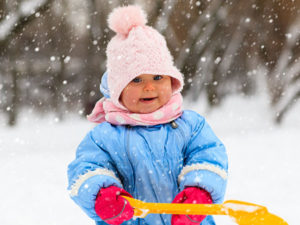 Don’t let snow and cold keep your children from outdoor play this winter. When dressed appropriately, the benefits children receive from playing outdoors far outweigh the fears of frost bite! Active outdoor play combats childhood obesity, promotes gross motor development and helps reduce stress—for parents and for children! It is common to hear adults say that “my child will not like being in the cold weather,” or “the cold is too dangerous to play in,” or “there’s nothing to play with.” It is up to adults to focus on the importance of children’s play, regardless of the season. After all, play should not be restricted to warm weather. Let’s approach the winter season with a playful attitude.
Don’t let snow and cold keep your children from outdoor play this winter. When dressed appropriately, the benefits children receive from playing outdoors far outweigh the fears of frost bite! Active outdoor play combats childhood obesity, promotes gross motor development and helps reduce stress—for parents and for children! It is common to hear adults say that “my child will not like being in the cold weather,” or “the cold is too dangerous to play in,” or “there’s nothing to play with.” It is up to adults to focus on the importance of children’s play, regardless of the season. After all, play should not be restricted to warm weather. Let’s approach the winter season with a playful attitude.
How Snowy, Cold Weather Benefits Children’s Development and Health
Before you go and curse the cold weather for keeping your playful children indoors all winter, let’s consider all of the benefits that cold weather has when it comes to children’s health, development, and well-being. Don’t just open the windows and let fresh air in, let the children out! Here are some benefits of outdoor play during the winter months, especially when snow is on the ground.
1. Increases in Exercise and Using Different Muscles
The winter months provide us with different ways of moving our bodies, such as sledding, walking up a snow hill, or building a snowman. Our larger muscles are put to great use in the winter months due to the challenges that snow provides. This large-muscle use and increase in physical activity support children’s gross motor development and overall health.
2. Getting Fresh Air and Avoiding Bacteria
The winter months can be commonly associated with getting colds and illnesses such as the flu. However, it is not the cold weather that necessarily causes colds and flus—it is increased exposure to indoor environments where bacteria and viruses live. For example, during the winter months, you turn on your home’s heating and venting systems. The bacteria and viruses within your home are continuously being moved around inside. Adults and children who spend long periods of time in a heated and poorly ventilated home, without exposure to fresh air, can easily pass germs to each other.
3. New Challenges and Problem-Solving
Weather that we consider “messy” provides environments and materials that are inspiring and fun for children; for example, large snow hills, and trees covered in snow. These environments provide children with opportunities for new challenges, such as climbing a snow hill. Engagement with outdoor environments in the winter provokes new problem-solving skills – “How can I slide down this ice patch without falling?” “How fast can I run up this snow hill?” “Can I climb this tree using a branch as a snow pick?” The ever-changing environments that the winter months have to offer provide children with the challenges that they so often crave.
4. Vitamin D Exposure
When we stay indoors during the winter, we are not only missing out on play, but also on necessary vitamins that the outdoor environment gives us. Children get vitamin D through sun exposure, and absorb it even though the sun is not as warm in the winter. Vitamin D helps regulate mental and emotional moods, doing so by increasing serotonin levels in the brain. Serotonin plays an important role in regulating mood and keeping us happy. So the more exposure you have to the sun, the higher your serotonin levels will be. It is recommended that you get at least half an hour of playtime outdoors in the winter.
Of course, if the temperatures are extremely low, you must use your best judgement to determine if your children should go outside and for how long.
So, bundle the kids up and take them out! It’s good for everyone, even you!
This article was written for the January 2019 edition of Parent Source.